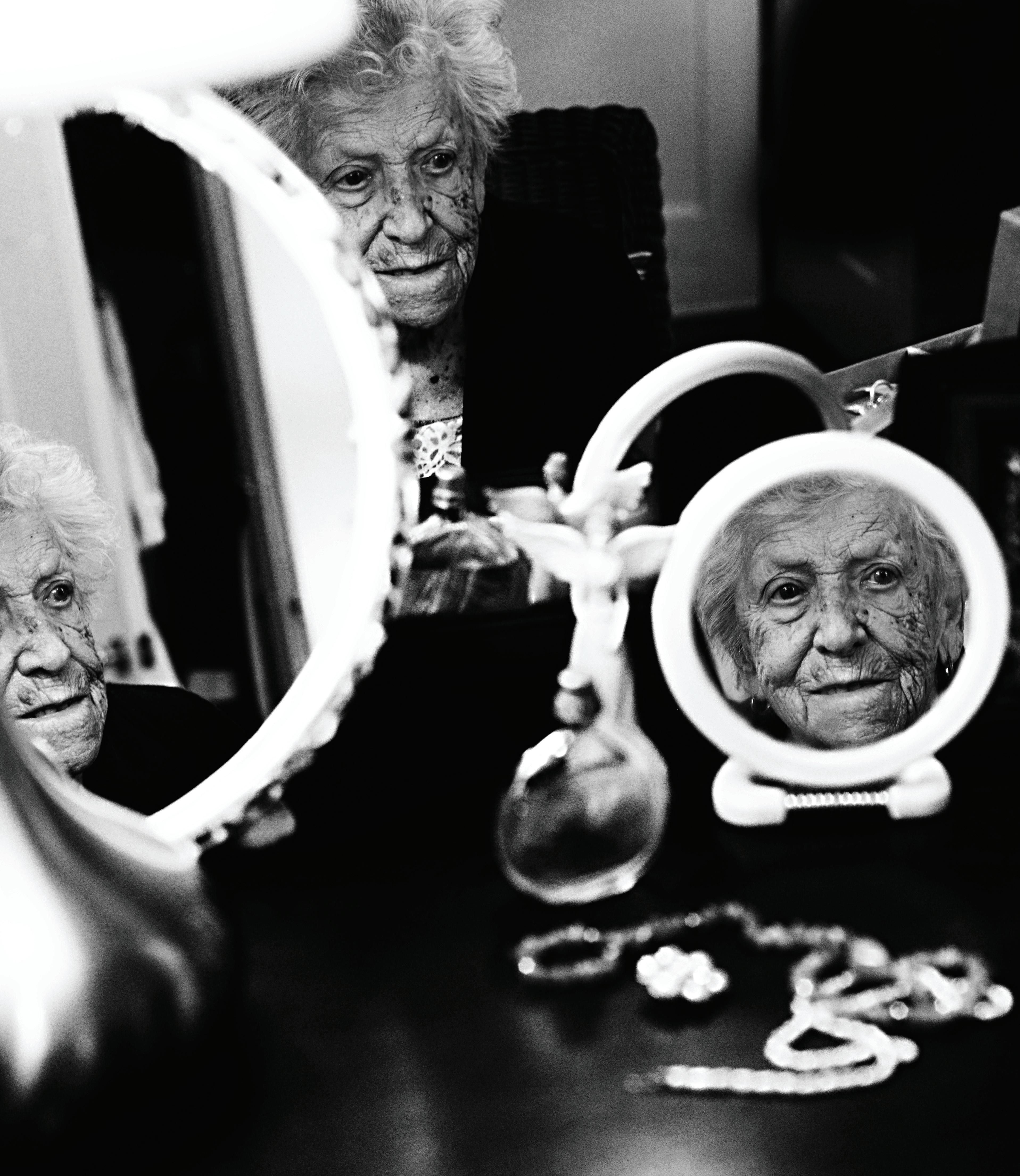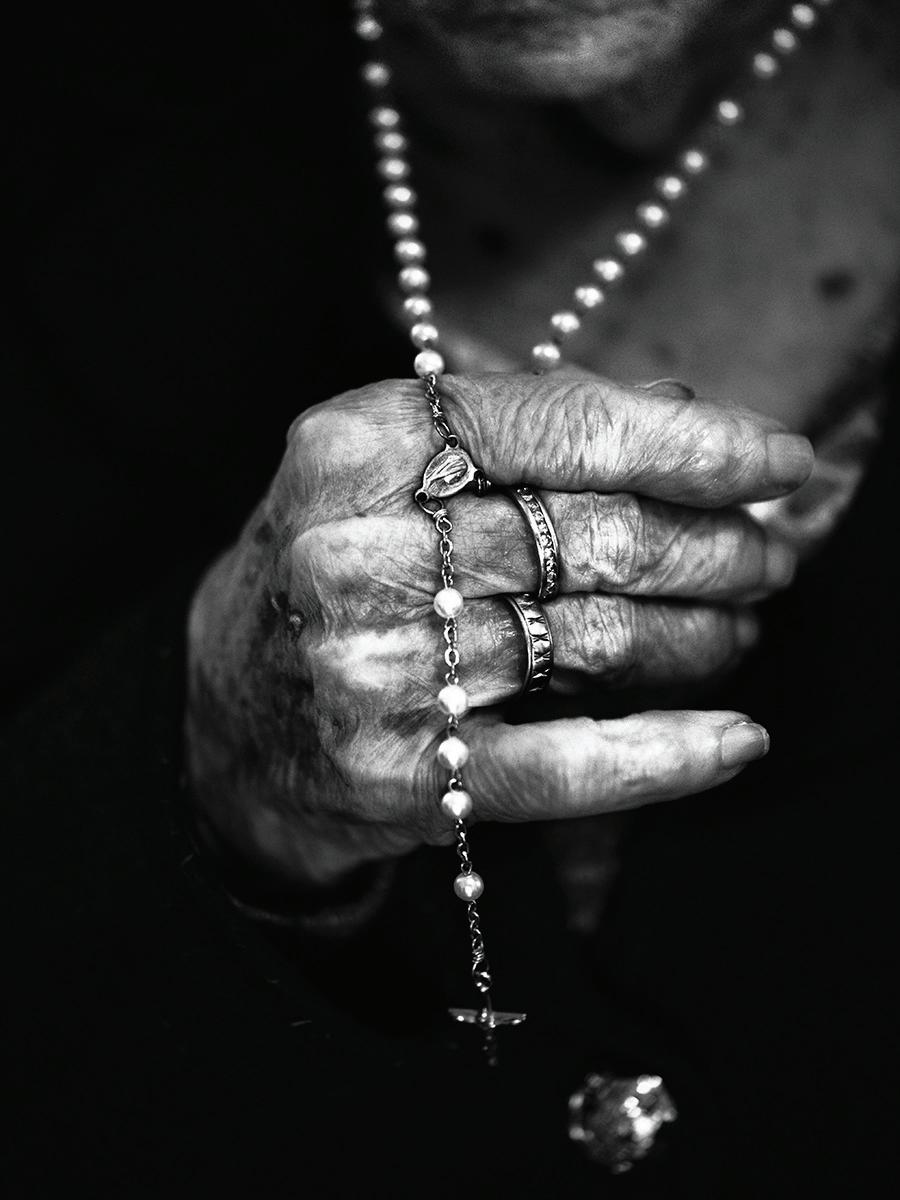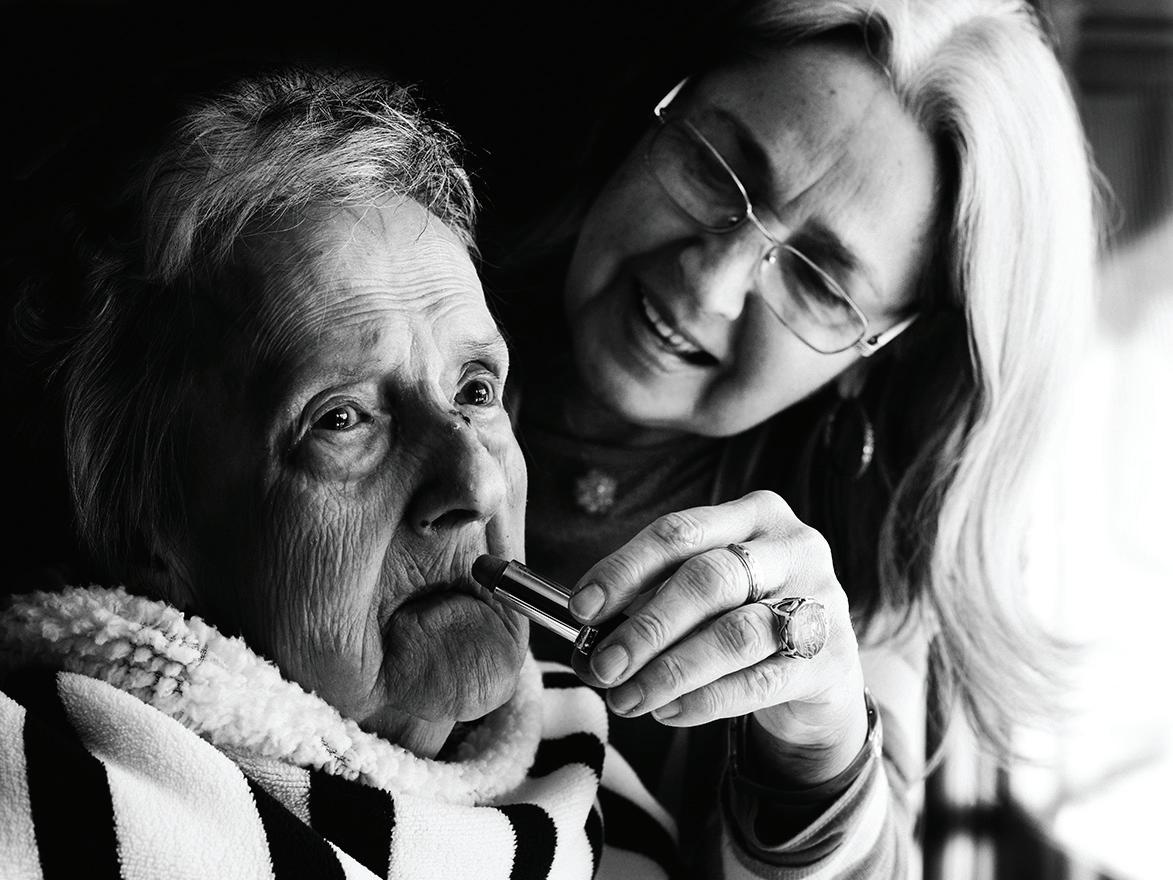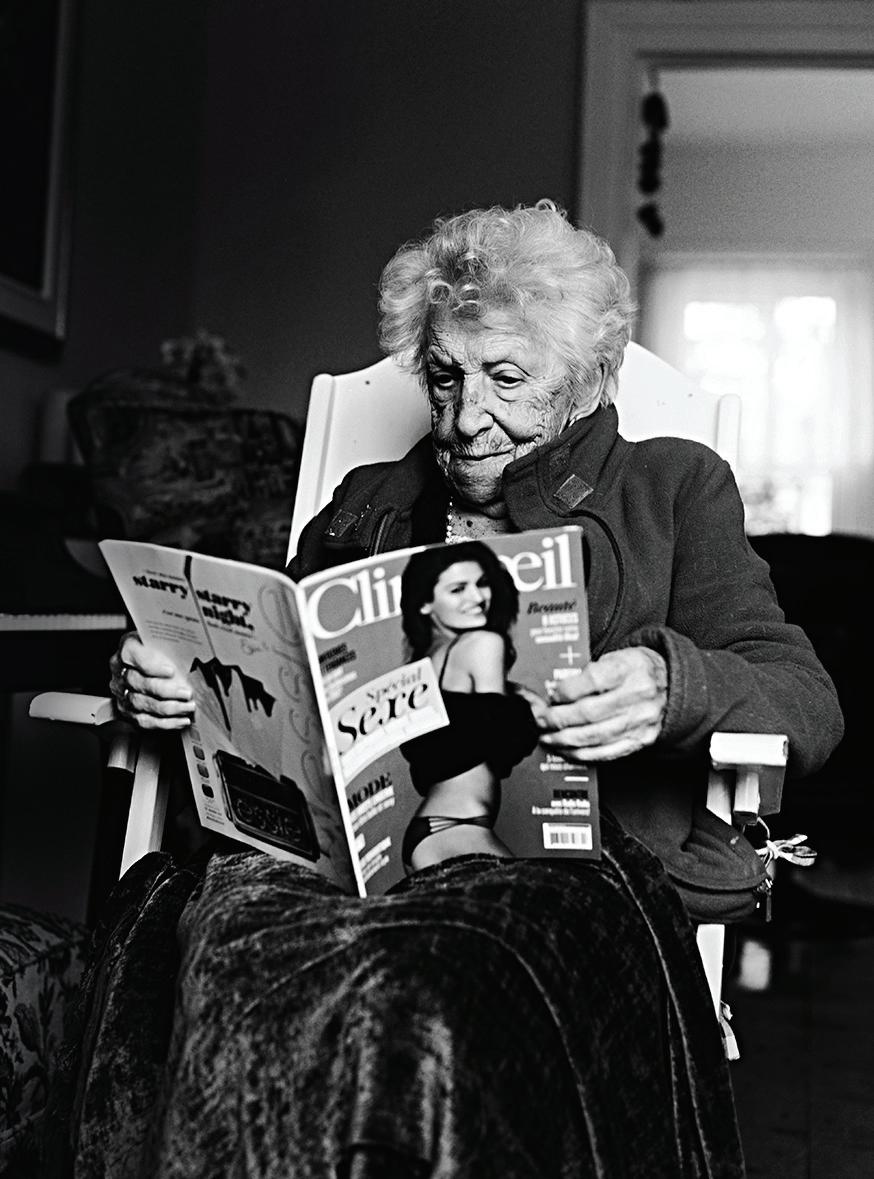
4 minute read
ARIANNE CLÉMENT 100 ANS, ÂGE DE BEAUTÉ
BY MEHREEN SHAHID

ARIANNE CLÉMENT TELLS the story of beauty stilled by time: beauty layered by decades of toil and turmoil, joy and celebration, charm and feminism. “I wanted to tell a story about women,” she says, explaining how she came up with the idea of photographing female centenarians in her community of Montérégie, Quebec. “I wanted to meet the oldest women of my community, as they are the ones who have seen the most changes of women’s conditions.”

“My father was a painter and craftsman and he shared his love of art with me. I believe that everything that is artistic is beautiful: theatre, picture frames, poems, paintings, flowers, songs. In a person, it’s the character, the silhouette, the smile, and the eyes that count. That said, my biggest regret is not getting an education. Doors open for you when you’re educated. Otherwise you feel shame. Regardless of the situation, I would advise young women to educate themselves.” — Marie-Berthe Paquette, 102 years old, Montreal QC, 2016.
When Clément started shooting, she could not decide on a precise direction to take with the project. “Back in the day, [women] were rarely photographed, and when it happened, it was considered an event,” she says. Clément’s path became clear when the women asked to prepare themselves before being photographed. Using as much natural light as possible, she captured participants in intimate moments as they got ready and beautified themselves. “The idea of the rituals of beauty came easily because the women I photographed all wanted to groom themselves for the shoot,” she says. “I took a lot of pictures of them, of their beauty rituals, and of the things they considered beautiful.” But that wasn’t what made the project special for Clément. She received the most joy from listening to the subjects’ stories about youth, old age, feminism, sexuality, charm, appearance, and love. She hopes sharing these memories made the women joyful, too. There was a lot of laughing and crying through the process. “The experience was very intimate for them as well as for me,” says Clément.

“As a young lady, I could not afford to be frivolous. We were poor and had to work all the time. We had to take part in day-to-day chores, pick the raspberries, take care of the babies, cook, help with the harvest, do housework, and bathe the children… and all of that without electricity. We didn’t have time to think about beauty.” — Solange Racine, 101 years old, Granby QC, 2016.
Conversations revealed varied self-views, from a centenarian seeing herself as “la fraîche” (the trendy lady), to others perceiving themselves as ugly and faded, but still looking to enjoy life. Clément hopes these portraits will help people to question society’s obsession with youth and beauty. She also seeks to give a voice to these women whose beauty is rarely acknowledged. “I feel [elderly people] are under-represented in society,” she says. “People who have a hundred years of age today are tremendously interesting. They went through a century of accelerated changes, and they have experienced so much.” What centenarians have to share is amazing, adds Clément: “I used to travel a lot in search of different visions of the world, but I realize now there is no need to go far to encounter people with values and logic that are different than mine. This is extremely enriching.”

“Even though we constantly told her that she was beautiful, my mom had always found herself ugly. She often said that she had a monkey face and that she didn’t like her plumpness. My mother regularly dieted. There were stretches where we went without potatoes, bread, or desserts. She also tried different weight loss pills. She wore girdles and corsets that she’d buy at Mrs. Dinovitzer’s store. I think her weight had always been her biggest fixation.” — Lise Provost (right) about her mother, Laure Saucier (left) whopassed away in 2016 at age 101, Acton Vale QC, 2016.
Clément began her career in photography as a journalist in Nunavut. Inspired by the experience, she went on to attain a master’s degree in photojournalism at the University of the Arts London in England. During her trips abroad, she developed a photographic style that combines art and documentary. From the Great North to the West Coast, the Amazon to Eastern Europe, and Argentina to Ireland, Clément’s recurrent theme of exploration has been that of the forgotten ones, the excluded, and the marginalized. Attracted to rough, coarse, and grainy textures, she is constantly on the lookout for powerful contrasts: lightness and dark, past and present, attractive and unsavoury, serenity and calamity, and life’s beauty and cold cruelty. “I like that the passage of time tells a story,” says Clément. “I have always been attracted to old houses, boats, trees, and people. Nothing seems more beautiful to me than the things that have been transformed, afflicted, crystallized, solidified, or decayed by time and the elements.” It’s no different when it comes to people, she explains: “They have seen so much, worked so much, experienced so much. Their bodies express that.”

“I personally find myself beautiful, and when I don’t, I do my best anyways! I like to have my hair neatly styled and wear dresses, jewellery and other accessories. I’ve always paid attention to my appearance. In fact, I’m known as ‘la fraîche’ (the trendy lady).” — Marie-Berthe Paquette, 102 years old, Montreal, 2016.

“When I was young, like all women, I wanted to be attractive. I curled my hair, wore the beautiful outfits my mom made for me and suffered in high heels. Still, I never wore makeup; I felt like it was fake. I married my husband because he was handsome, which I ended up regretting. He wasn’t a very good partner and I ended up kicking him out.” — Madeleine Beaugrand Champagne, 101 ans, St-Bruno de Montarville, 2016.

“When I was young I had long hair, nice legs, and curves. Young ladies today all strive to be skinny, but I think that real beauty is natural beauty. We are who we are, and that’s all that matters.” — Anne-Marie Pronovost, 100 years old, Sutton QC, 2016.
In this sesquicentennial year of Canada’s unification, Clément sees a special connection between her subjects and the country. To her, this unique bond is incredible, making these centenarians the core bearers of the nation’s heritage and history. “They are among the oldest in the country. They are the ones who have seen the most of Canada and all of its changes in the last century,” she says. “I can’t start to imagine how much they had to adjust to: they went through two world wars, the Great Depression, the right to vote for women, the baby boom, the arrival of television, the Quiet Revolution, the sexual revolution, the technology revolution, etcetera.”

“Of course I’d rather be good-looking than ugly! But back when I was young, I couldn’t be bothered with beauty. It was vanity. It was a sin. What really mattered was the family, putting food on the table, and making sure that the children were bathed and clothed. I am blessed because my daughter is the one now taking care of me. She welcomed me in her home 20 years ago and I am still there. Family is all that really matters.” — Isabelle Gagné, 103 years old, Clermont QC, 2016.
Using a grant from the Conseil des arts et des lettres du Québec, Clément hopes to continue her endeavours. She has easily formed intimate and personal connections with her subjects. The hard part, Clément states, is performing administrative tasks, such as writing grant proposals; submitting work to contests, festivals, and magazines; and finding exhibitors. However, receiving recognition from her peers has made this work worthwhile. Clément aims to push her project further, documenting more and more centenarians elsewhere in Canada and even around the world.

“The word beauty invokes great classic French authors, and music. When I was young, I always had my nose in a book and I wrote. I don’t mean to brag, but people envied my writing skills. I like Mozart a lot, but it’s Beethoven who really makes my heart sing.” — Madeleine Beaugrand Champagne, 101 years old, Saint-Bruno-de-Montarville, QC, 2016.


